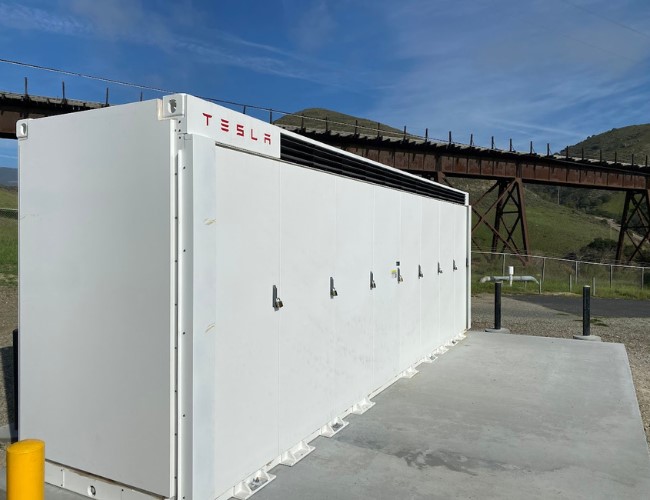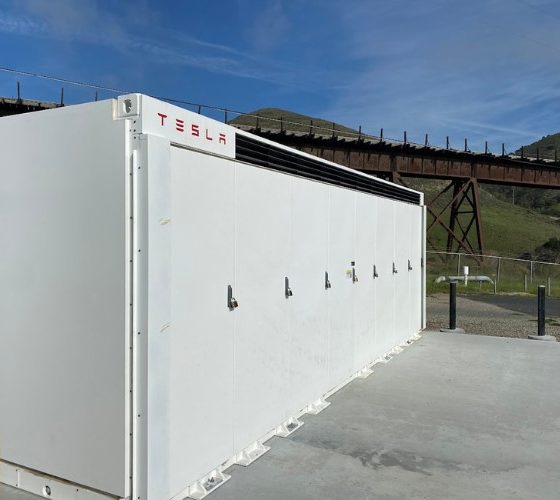A new Tesla Megapack has been installed at a water treatment plant in San Luis Obispo, California, according to a new report.
The City of San Luis Obispo installed a Tesla Megapack energy storage unit at its water treatment facility, as reported by Paso Robles Daily on Monday. The battery is part of the city’s commitment to “leading by example in climate action work” and its initiative to reach carbon neutrality on city operations by 2030.
“The installation of the Tesla battery system at our water treatment plant is a testament to our city’s commitment to sustainability, innovation, and resilience. I’m proud of the work our team has done to make this vision a reality,” said City Utilities Director Aaron Floyd.
The Megapack was funded with grant funding from the Pacific Gas & Energy’s (PG&E’s) Self-Generation Incentive Program, meaning that the unit was installed at no cost to the community. The battery storage system project began last year and comes as a larger part of the city’s goals to continually modernize its utility equipment.
“This project not only exemplifies the positive impact of grant-funded initiatives but also demonstrates our dedication to providing clean, reliable, and cost-effective services to our community,” Floyd added. “It’s a win-win for both our residents and the environment.”
Additionally, the Megapack was seamlessly installed at the treatment plant, so the site did not experience any operation interruptions. The city has pointed out the following three benefits of the Tesla Megapack:
Three key benefits of the Tesla battery system
- Smoothing peak energy demand: The water treatment plant relies heavily on energy during equipment start-up and peak operational periods, which can strain the power grid and escalate electrical costs. The Tesla battery system will shift energy demand to the battery during these high-demand periods, effectively reducing spikes in energy consumption and relieving pressure on the PG&E power grid.
- Optimizing energy use: The Tesla battery can be charged during periods when electricity is cheapest, most abundant, and provided from clean sources such as solar and wind. Once charged during off-peak hours, the battery can be programmed to power operations during peak energy demand periods when power is expensive, the power grid is stressed, and the grid is more reliant on energy from less sustainable sources.
- Enhancing resilience: When charged, the Tesla battery will be utilized to power the water treatment plant if there is a scheduled or unscheduled loss in PG&E power to the facility. Seamless transition from PG&E power to battery power is important, as it will ensure continuous operation of the facility while reducing the use of the onsite backup diesel generator (further reducing greenhouse gas emissions). The Tesla battery pack is estimated to be capable of operating the entire water treatment plant and the city’s largest water pump station for up to seven hours.
Tesla has deployed its scalable Megapack energy storage systems around the world, recently including projects at a Panasonic testing site in Kyoto, Japan, at the company’s own Gigafactory in Austin, Texas, and a number of projects in Australia, among others still.
The company has also been ramping up production of Megapacks at its Lathrop, California Megafactory and preparing to build a plant for the energy storage systems in Shanghai, China.
What are your thoughts? Let me know at zach@teslarati.com, find me on X at @zacharyvisconti, or send your tips to us at tips@teslarati.com.

News
Tesla FSD fleet is nearing 7 billion total miles, including 2.5 billion city miles
As can be seen on Tesla’s official FSD webpage, vehicles equipped with the system have now navigated over 6.99 billion miles.

Tesla’s Full Self-Driving (Supervised) fleet is closing in on almost 7 billion total miles driven, as per data posted by the company on its official FSD webpage.
These figures hint at the massive scale of data fueling Tesla’s rapid FSD improvements, which have been quite notable as of late.
FSD mileage milestones
As can be seen on Tesla’s official FSD webpage, vehicles equipped with the system have now navigated over 6.99 billion miles. Tesla owner and avid FSD tester Whole Mars Catalog also shared a screenshot indicating that from the nearly 7 billion miles traveled by the FSD fleet, more than 2.5 billion miles were driven inside cities.
City miles are particularly valuable for complex urban scenarios like unprotected turns, pedestrian interactions, and traffic lights. This is also the difference-maker for FSD, as only complex solutions, such as Waymo’s self-driving taxis, operate similarly on inner-city streets. And even then, incidents such as the San Francisco blackouts have proven challenging for sensor-rich vehicles like Waymos.
Tesla’s data edge
Tesla has a number of advantages in the autonomous vehicle sector, one of which is the size of its fleet and the number of vehicles training FSD on real-world roads. Tesla’s nearly 7 billion FSD miles then allow the company to roll out updates that make its vehicles behave like they are being driven by experienced drivers, even if they are operating on their own.
So notable are Tesla’s improvements to FSD that NVIDIA Director of Robotics Jim Fan, after experiencing FSD v14, noted that the system is the first AI that passes what he described as a “Physical Turing Test.”
“Despite knowing exactly how robot learning works, I still find it magical watching the steering wheel turn by itself. First it feels surreal, next it becomes routine. Then, like the smartphone, taking it away actively hurts. This is how humanity gets rewired and glued to god-like technologies,” Fan wrote in a post on X.
News
Tesla starts showing how FSD will change lives in Europe
Local officials tested the system on narrow country roads and were impressed by FSD’s smooth, human-like driving, with some calling the service a game-changer for everyday life in areas that are far from urban centers.

Tesla has launched Europe’s first public shuttle service using Full Self-Driving (Supervised) in the rural Eifelkreis Bitburg-Prüm region of Germany, demonstrating how the technology can restore independence and mobility for people who struggle with limited transport options.
Local officials tested the system on narrow country roads and were impressed by FSD’s smooth, human-like driving, with some calling the service a game-changer for everyday life in areas that are far from urban centers.
Officials see real impact on rural residents
Arzfeld Mayor Johannes Kuhl and District Administrator Andreas Kruppert personally tested the Tesla shuttle service. This allowed them to see just how well FSD navigated winding lanes and rural roads confidently. Kruppert said, “Autonomous driving sounds like science fiction to many, but we simply see here that it works totally well in rural regions too.” Kuhl, for his part, also noted that FSD “feels like a very experienced driver.”
The pilot complements the area’s “Citizen Bus” program, which provides on-demand rides for elderly residents who can no longer drive themselves. Tesla Europe shared a video of a demonstration of the service, highlighting how FSD gives people their freedom back, even in places where public transport is not as prevalent.
What the Ministry for Economic Affairs and Transport says
Rhineland-Palatinate’s Minister Daniela Schmitt supported the project, praising the collaboration that made this “first of its kind in Europe” possible. As per the ministry, the rural rollout for the service shows FSD’s potential beyond major cities, and it delivers tangible benefits like grocery runs, doctor visits, and social connections for isolated residents.
“Reliable and flexible mobility is especially vital in rural areas. With the launch of a shuttle service using self-driving vehicles (FSD supervised) by Tesla in the Eifelkreis Bitburg-Prüm, an innovative pilot project is now getting underway that complements local community bus services. It is the first project of its kind in Europe.
“The result is a real gain for rural mobility: greater accessibility, more flexibility and tangible benefits for everyday life. A strong signal for innovation, cooperation and future-oriented mobility beyond urban centers,” the ministry wrote in a LinkedIn post.
News
Tesla China quietly posts Robotaxi-related job listing
Tesla China is currently seeking a Low Voltage Electrical Engineer to work on circuit board design for the company’s autonomous vehicles.

Tesla has posted a new job listing in Shanghai explicitly tied to its Robotaxi program, fueling speculation that the company is preparing to launch its dedicated autonomous ride-hailing service in China.
As noted in the listing, Tesla China is currently seeking a Low Voltage Electrical Engineer to work on circuit board design for the company’s autonomous vehicles.
Robotaxi-specific role
The listing, which was shared on social media platform X by industry watcher @tslaming, suggested that Tesla China is looking to fill the role urgently. The job listing itself specifically mentions that the person hired for the role will be working on the Low Voltage Hardware team, which would design the circuit boards that would serve as the nervous system of the Robotaxi.
Key tasks for the role, as indicated in the job listing, include collaboration with PCB layout, firmware, mechanical, program management, and validation teams, among other responsibilities. The role is based in Shanghai.
China Robotaxi launch
China represents a massive potential market for robotaxis, with its dense urban centers and supportive policies in select cities. Tesla has limited permission to roll out FSD in the country, though despite this, its vehicles have been hailed as among the best in the market when it comes to autonomous features. So far, at least, it appears that China supports Tesla’s FSD and Robotaxi rollout.
This was hinted at in November, when Tesla brought the Cybercab to the 8th China International Import Expo (CIIE) in Shanghai, marking the first time that the autonomous two-seater was brought to the Asia-Pacific region. The vehicle, despite not having a release date in China, received a significant amount of interest among the event’s attendees.










